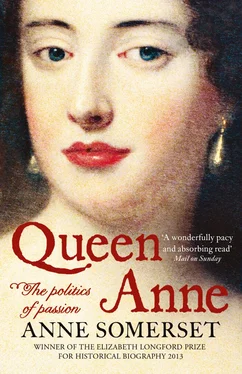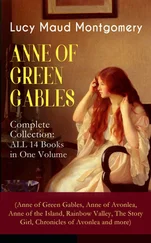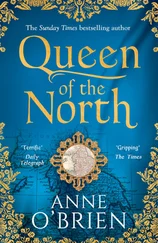The Politics of Passion
A Biography

OTHER BOOKS BY ANNE SOMERSET
The Life and Times of King William IV
Elizabeth I
Unnatural Murder: Poison at the Court of James I
The Affair of the Poisons
Ladies in Waiting: From the Tudors to the Present Day
For Dad, with love
The book is also dedicated to the memory of my husband, Matthew Carr. He was always the first person to be shown the typescript of my books and although he died before he could read it all, he delighted me with his enthusiasm for the sections he did see. It is one of many ways in which he is greatly missed.
Cover
Title Page
Other Books by Anne Somerset
Dedication
The House of Stuart
List of Illustrations
Author’s Note
1 But a Daughter
2 Religion Before Her Father
3 Sure Never Anybody Was Used So
4 We Are Now in a New World
5 These Fatal Distinctions of Whig and Tory
6 The Weight and Charge of a Kingdom
7 Nothing But Uneasiness
8 Entire and Perfect Union
9 Guided by Other Hands
10 Passions Between Women
11 Making the Breach Wider
12 The Heat and Ferment that is in This Poor Nation
13 I Do Not Like War
14 The Great Work of Peace
15 The Last Troublesome Scene of Contention
16 Not Equal to the Weight of a Crown?
Picture Section
Acknowledgements
Endnotes
Bibliography
Searchable Terms
Copyright
About the Publisher

James II, when Duke of York, with Anne Hyde and their two daughters, Princess Mary and Princess Anne c. 1674–80. By Sir Peter Lely and Benedetto Gennari. (The Royal Collection © 2011)
The Lady Anne as a child. Artist Unknown. (Royal Collection © 2011)
Queen Anne when Princess of Denmark. By Willem Wissing and Jan van der Vaardt. (© Scottish National Portrait Gallery)
Sarah Churchill (later the Duchess of Marlborough) with Lady Fitzharding, 1691. By Sir Godfrey Kneller. (© Blenheim Palace, Oxfordshire, UK/The Bridgeman Art Library)
Prince George of Denmark on horseback, 1704. By Michael Dahl. (Royal Collection © 2011)
Princess Anne of Denmark with the Duke of Gloucester, c. 1694. After Kneller (© The National Portrait Gallery, London)
Queen Mary II. After Willem Wissing. (© The National Portrait Gallery, London)
William, the Duke of Gloucester, with his friend, Benjamin Bathurst. After Thomas Murray © The National Portrait Gallery, London)
Queen Anne, 1703. By Edmund Lilly. (© Queen Anne, 1703, Lilly, Edmund (fl.1702–d.1716)/Blenheim Palace, Oxfordshire, UK/The Bridgeman Art Library)
Sidney Godolphin. After Sir Godfrey Kneller. (© The National Portrait Gallery, London)
The Duke of Marlborough. By Sir Godfrey Kneller. (© The National Portrait Gallery, London)
Queen Anne with Prince George of Denmark. By Charles Boit, 1706. (Royal Collection © 2011)
Print of ‘Her Majesties Royal Palace at Kensington’. (© British Museum)
Tapestry showing the French Marshal Tallard surrendering his baton to the Duke of Marlborough after the Battle of Blenheim in August 1704. (Image reproduced by kind permission of His Grace the Duke of Marlborough, Blenheim Palace Image Library)
Robert Harley Earl of Oxford. By Jonathan Richardson. (© Private Collection/Photo © Philip Mould Ltd, London/The Bridgeman Art Library)
Sophia Electress of Hanover. (Royal Collection © 2011)
Portrait believed to be of Abigail Masham. (© Philip Mould Ltd London/The Bridgeman Art Library)
Henry St John, Viscount Bolingbroke. By George White, after Thomas Murray. (© The National Portrait Gallery, London)
Prince James Francis Edward Stuart (the Pretender). Studio of Alexis Simon Belle. (© The National Portrait Gallery, London)
Anne in the House of Lords. By Peter Tillemanns. (Royal Collection © 2011)
The Battle of Malplaquet, 11 September 1709, c. 1713. By Louise Laguerre. (© National Army Museum, London/The Bridgeman Art Library)
Satirical print of Bolingbroke dictating business relating to the Treaty of Utrecht. (© British Museum)
Queen Anne and the Knights of the Garter. By Peter Angelis. (© The National Portrait Gallery)
For the sake of clarity I have updated spelling and punctuation used in original documents. Furthermore, in almost all cases when Anne or her contemporaries used the abbreviations ‘ye’ and ‘yt’ in their letters, I have modernised the archaic usage by substituting ‘the’ and ‘that’. Very often Anne and her ministers ciphered their letters by substituting numbers for names. In such cases I have omitted the numbers and replaced them with the relevant name in square brackets.
Throughout Anne’s lifetime, England used the Julian Calendar, while continental Europe followed the Gregorian system. During the seventeenth century, the date in Europe was ten days ahead of England’s; with the start of the eighteenth century the gap between England and Europe widened to a difference of eleven days. When dealing with events that took place in England, I give dates according to the Julian Calendar. However, when describing events that occurred on the Continent, or when quoting letters sent from abroad, I generally give a composite date, separated by a forward slash, indicating the date according to both the Julian and Gregorian calendars. Whereas in Stuart England, the calendar year started on 25 March, I have simplified things by taking it to begin on 1 January.
It is notoriously difficult to compare the value of money in the past with modern monetary values. However, as a very rough guide it should be noted that the National Archives’ Currency Converter Service calculates that £1 in 1710 would have a spending worth of £76.59 in 2005.

The opening weeks of the year 1665 were particularly cold, and the sub-zero temperatures had discouraged the King of England, Charles II, from writing to his sister Henrietta in France. He was always a lazy correspondent, and having little news to impart thought it pointless ‘to freeze my fingers for nothing’. In early February, however, he took up his pen to report that the two of them had acquired a new niece. On 6 February, shortly before midnight at St James’s Palace in London, their younger brother James, Duke of York, had become a father to a healthy baby girl. Being without a legitimate heir, the King would have preferred a boy, and since Henrietta herself was expecting a child, Charles told her that he trusted she would have ‘better luck’ in this respect. In one way, however, the Duchess of York had been fortunate, for she had had a remarkably quick labour, having ‘despatched her business in little more than an hour’. Charles wrote that he wished Henrietta an equally speedy delivery when her time came, though he feared that her slender frame meant that she was ‘not so advantageously made for that convenience’ as the far more substantially built Duchess. The King concluded that in that event, ‘a boy will recompense two grunts more’. 1
Читать дальше















